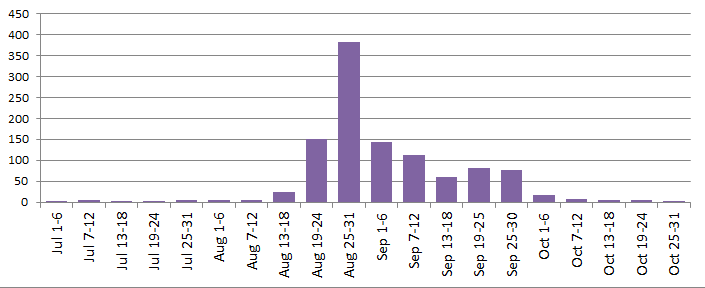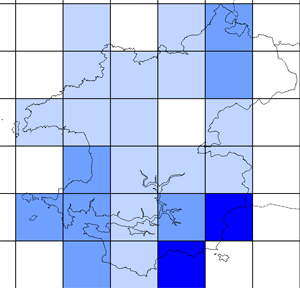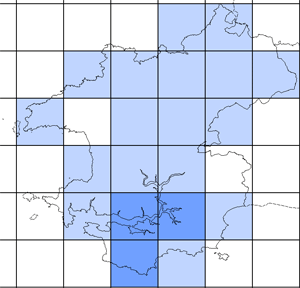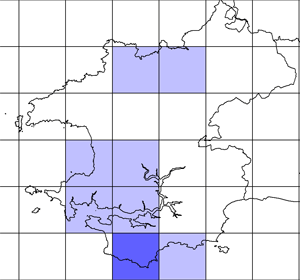Entries in passerine (82)
Goldcrest - 1980s winter atlas
 Sunday, October 9, 2011 at 6:07PM
Sunday, October 9, 2011 at 6:07PM 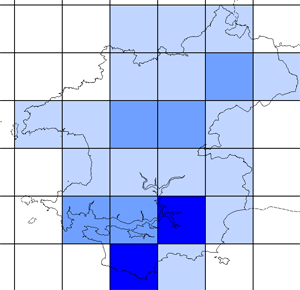
The BTO winter atlas showed that Goldcrests were present in most 10km squares during the winters of 1981-82, 1982-82 and 1983-84.
The darker the colour, the higher the relative total count for each 10km square. The darkest blue represents over 20 birds.
However, it should be noted that the figures show a high correlation with the number of recording cards returned (therefore related to recording effort) for each 10km square.
Graham Rees
Grey Wagtail - 1980s winter atlas
 Sunday, September 18, 2011 at 4:17PM
Sunday, September 18, 2011 at 4:17PM 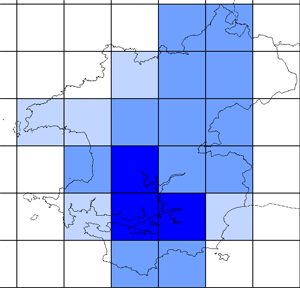
The BTO winter atlas showed that Grey Wagtails were present in most 10km squares during the winters of 1981-82, 1982-82 and 1983-84.
The darker the colour, the higher the relative total count for each 10km square. The darkest blue represents over 4 birds.
The map plot shows a slightly wider winter distribution than that of the breeding season.
Graham Rees
Dunnock - 1980s winter atlas
 Friday, September 16, 2011 at 12:12PM
Friday, September 16, 2011 at 12:12PM 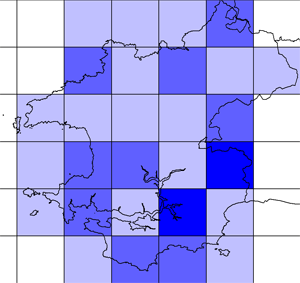
The BTO winter atlas showed that Dunnocks were present in all 10km squares during the winters of 1981-82, 1982-82 and 1983-84.
The darker the colour, the higher the relative total count for each 10km square. The darkest blue represents over 24 birds.
However, it should be noted that the figures show a high correlation with the number of recording cards returned (therefore related to recording effort) for each 10km square.
Graham Rees
Coal Tit - 1980s winter atlas
 Friday, September 16, 2011 at 11:59AM
Friday, September 16, 2011 at 11:59AM 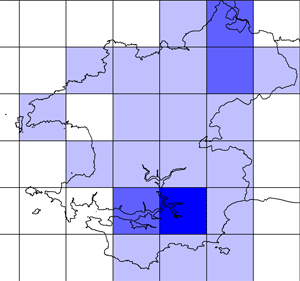
The BTO winter atlas showed that Coal Tit were present in most 10km squares during the winters of 1981-82, 1982-82 and 1983-84.
The darker the colour, the higher the relative total count for each 10km square. The darkest blue represents over 18 birds in a day. Probably numerically under recorded in dense conifer plantations during winter when they do not normally reveal themselves by singing.
Graham Rees
Chiff-chaff - 1980s winter atlas
 Friday, September 16, 2011 at 11:57AM
Friday, September 16, 2011 at 11:57AM 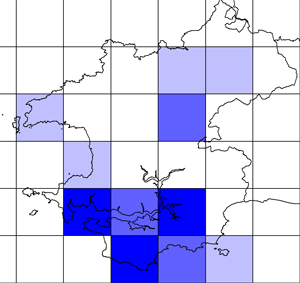
The BTO winter atlas showed that Chiffchaffs were present in 41% of 10km squares during the winters of 1981-82, 1982-82 and 1983-84.
The darker the colour, the higher the relative total count for each 10km square. The darkest blue represents 3 or more birds seen in a day.
However, it should be noted that the figures show a high correlation with the number of recording cards returned (therefore related to recording effort) for each 10km square.
Graham Rees
Bullfinch - 1980s winter atlas
 Friday, September 16, 2011 at 11:51AM
Friday, September 16, 2011 at 11:51AM 
The BTO winter atlas showed that Bullfinches were present in most 10km squares during the winters of 1981-82, 1982-82 and 1983-84.
The darker the colour, the higher the relative total count for each 10km square. The darkest blue represents over 15 birds recorded in a day. The largest gatherings were due to birds from the surrounding neighbourhood gathering at good local food sources.
Graham Rees
Yellow Wagtail - races
 Sunday, February 13, 2011 at 11:35AM
Sunday, February 13, 2011 at 11:35AM Motacilla flava
As well as the breeding and probable breeding birds noted before, male Blue – headed Wagtails, M. f. flava, which breed in Europe from southern Scandinavia to France,have been recorded in the spring on several occasions: at Skokholm on the 15th May 1958, on the 12th – 14th May 1959, two on the 18th May 1961, on the 29th & 30th May 1963, on the 29th June 1964, on the 27th May 1967, on the 17th May 1982, on the 16th May 1983, on the 12th June 1984, on the 15th – 18th June 1987, on the 11th – 17th June 1988, on the 4th, 8th, 11th and 13th – 14th May 1989, on the 11th May and 27th May 1991, on the 6th May, 22nd and 29th May 1992, on the 27th May 1993, on the 20th April 1996, and on the 26th May 1997, at Skomer on the 21st May 1997, on the 29th April 2000, on the 18th – 23rd May 1996, on the 14th May 1992, on the 21st May 1993, and at Ramsey on 18th May 1985.
There are also autumn sightings on record, which should perhaps be treated with caution until any recorded details of their appearance can be scrutinised. Plumage becomes abraded and bleached during the summer and moult to winter plumage occurs in August and September. The records are included for future evaluation: two Skomer on the 18th September 1961, two there on the 27th August 1990, one Dale airfield on the 20th September 1986, one Skokholm on the 23rd August 1988, one there on the 4th September 2000, with two on the 24th September 2000, one on the 1st October 2001 and one on the 9th – 12th September 2003.
Grey – headed Wagtails M. f. thunbergi breed from central and north Scandinavia to north - west Siberia. Males of this race were recorded on passage through Pembrokeshire as follows: at Skokholm on the 31st May 1978, on the 13th – 15th April 1979, on the 13th May 1979, on the 17th May 1982, on the 10th – 12th May 1987, on the 3rd – 5th May 1989, on the 31st May – 5th June 1990, and on the 25th June 1992, at Strumble Head on the 29th May 1983 and Flimston on the 30th May 1998.
A male Spanish Blue – headed Wagtail M. f. iberiae, which breeds in Iberia and Tunisia, was recorded at Skokholm on the 19th April 1989.
A male Ashy – headed Wagtail M. f. cinereocapilla, which breeds in Sicily, Sardinia, Italy and Slovenia, was recorded at Skokholm from the 17th to the 20th May 1992.
A male Black – headed Wagtail M. f. feldegg, which breeds in the Balkans, Turkey, Caspian, Iran and Afghanistan, was recorded at Skomer on the 7th May 1986.
Graham Rees.
(Covers records up to and including 2008).
Yellow Wagtail - analysis
 Sunday, February 13, 2011 at 11:34AM
Sunday, February 13, 2011 at 11:34AM Motacilla flava
Yellow Wagtails have been recorded all around the coast, flying past or feeding on open ground, particularly pasture land with cattle. They have been seen on all of the offshore islands, even Grassholm, a large percentage of the county records being from Skokholm where there has been daily observation continuously since 1946. A few records were from the Teifi Marshes but very few from further inland, the only ones traced being five at Cilwendeg on the 24th August 1867, one at Crymych on the 7th June 1984, one Pen Gawse on the 6th May 1989, one Brynberian on the 2nd September 2001 and one Canaston Oaks on the 7th August 2008.
Yellow Wagtails have drastically declined in the UK since the 1980’s, by 70% between 1981 and 2006. This decline is reflected in the Pembrokeshire records as illustrated in the accompanying graph covering the years 1983 to 2007.
Pembrokeshire: trend in the number of birds per annum.
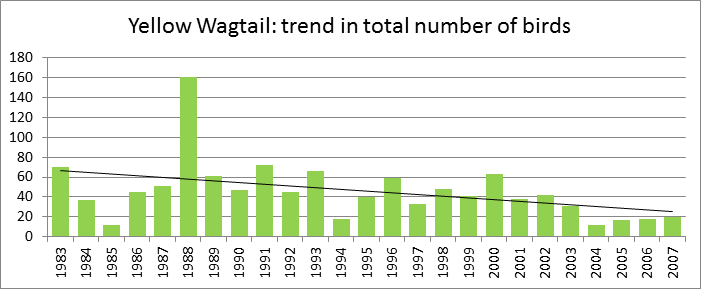
Yellow Wagtail - autumn
 Sunday, February 13, 2011 at 11:33AM
Sunday, February 13, 2011 at 11:33AM Motacilla flava
Autumn passage has been recorded from the 1st July to the 30th October, with two November records.
There have been very few recorded in July and early August. Peak passage took place from mid August to September. The end of August has clearly been the time of maximum presence, when the largest concentrations of up to 50 birds were noted at Skokholm and Talbenny during the 1960’s. Betts (1992) notes “up to 150 in August 1952” at Skokholm but is not date specific, so these could not be fitted into the histogram. Passage has tailed off rapidly during October. There have been two November occurrences, on the 2nd at Mullock in 1981 and on the 18th at Skokholm in 1967.
Yellow Wagtail: pattern of occurrence
